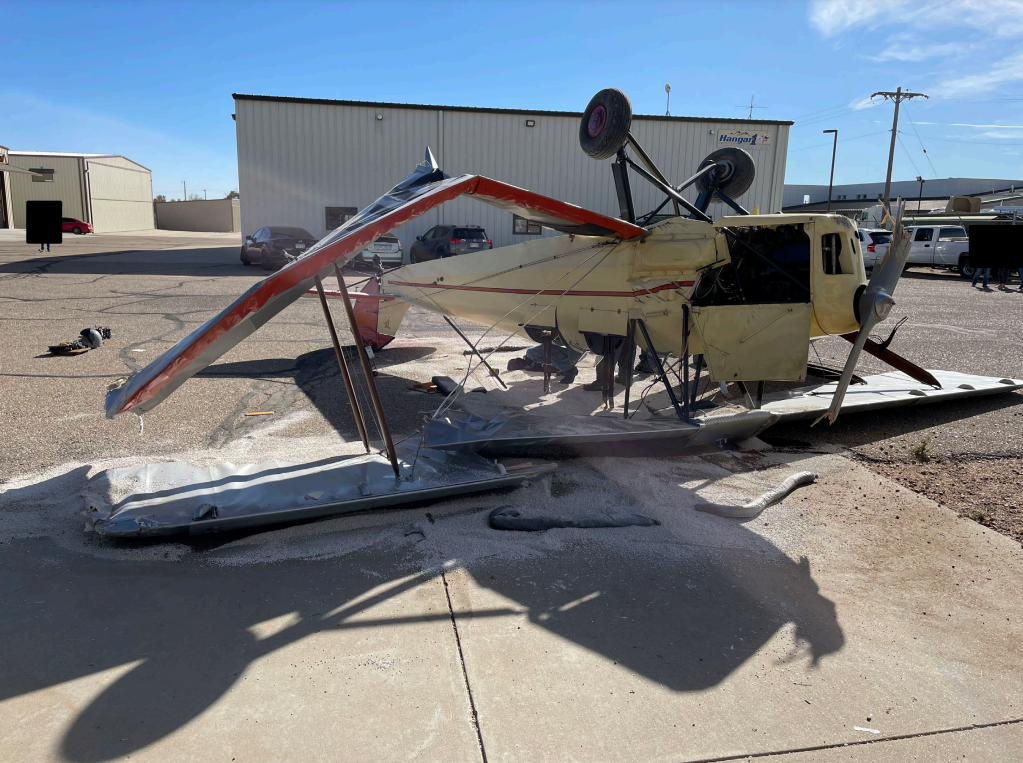
ASN Wikibase Occurrence # 346975
This information is added by users of ASN. Neither ASN nor the Flight Safety Foundation are responsible for the completeness or correctness of this information.
If you feel this information is incomplete or incorrect, you can submit corrected information.
| Date: | Tuesday 17 October 2023 |
| Time: | 14:30 |
| Type: |  de Havilland DH-82A Tiger Moth Mk II |
| Owner/operator: | Voyager 180 LLC |
| Registration: | N41DH |
| MSN: | 84734 |
| Year of manufacture: | 1972 |
| Total airframe hrs: | 2766 hours |
| Fatalities: | Fatalities: 0 / Occupants: 2 |
| Aircraft damage: | Substantial |
| Category: | Accident |
| Location: | Greeley-Weld County Airport (GXY/KGXY), Greeley, CO -
 United States of America United States of America
|
| Phase: | Initial climb |
| Nature: | Private |
| Departure airport: | Greeley-Weld County Airport, CO (GXY/KGXY) |
| Colorado Springs-USAF Academy Airport, CO (AFF/KAFF) | |
| Investigating agency: | NTSB |
| Confidence Rating: |
On October 17, 2023, at about 1430 local time, a de Havilland DH-82A Tiger Moth Mk II, N41DH, sustained substantial damage when it was involved in an accident at Greeley-Weld County Airport (GXY/KGXY), Greeley, Colorado. The commercial pilot and one passenger were not injured.
The pilot and pilot-rated-passenger intended to complete a personal cross-country flight with variable wind about 6 knots at the departure airport. The pilot noted the windsock nearest the airplane indicated a tailwind, but the other windsocks farther down the runway indicated a headwind or crosswind. During takeoff, the airplane became airborne faster than expected and climbed well, so the pilot made an early right turn over airport hangars. The airplane’s upper wing slats fluttered which indicated to the pilot that the airspeed was low, then they “came out hard,” which indicated the airplane was near a stall. The pilot ensured the throttle was full forward and decreased pitch attitude to maintain airspeed but felt like the airplane “was being forced down.” Unable to maintain altitude, and with no suitable forced landing area, he maneuvered the airplane to collide with the side of a hangar and the ground, then it nosed over. The airplane sustained substantial damage to the wings, fuselage, and empennage. The pilot reported that there were no preaccident mechanical malfunctions or failures that would have precluded normal operation.
Airport surveillance video showed the airplane at low altitude and appeared to climb until it overflew airport hangars. The airplane maintained a climb pitch attitude as it descended into the hangars.
Probable Cause: The pilot’s decision to turn out early during the initial climb and failure to maintain adequate airspeed/angle-of-attack, which resulted in an aerodynamic stall and impact with airport hangars. Contributing to the accident was the variable wind conditions above the hangars and the pilot’s lack of awareness of those conditions.
Accident investigation:
 |
|
Sources:
NTSB
https://data.ntsb.gov/Docket?ProjectID=193262
https://aerialvisuals.ca/AirframeDossier.php?Serial=24680
https://media.abpic.co.uk/pictures/full_size_0335/1503147-large.jpg (photo)
Location
Images:

Photo: NTSB
Revision history:
| Date/time | Contributor | Updates |
|---|---|---|
| 18-Oct-2023 20:07 | Captain Adam | Added |
| 29-Oct-2023 21:50 | Captain Adam | Updated |
| 20-Nov-2023 21:42 | Captain Adam | Updated [Phase, Source, Narrative, Photo] |
Corrections or additions? ... Edit this accident description
The Aviation Safety Network is an exclusive service provided by:


 ©2024 Flight Safety Foundation
©2024 Flight Safety Foundation